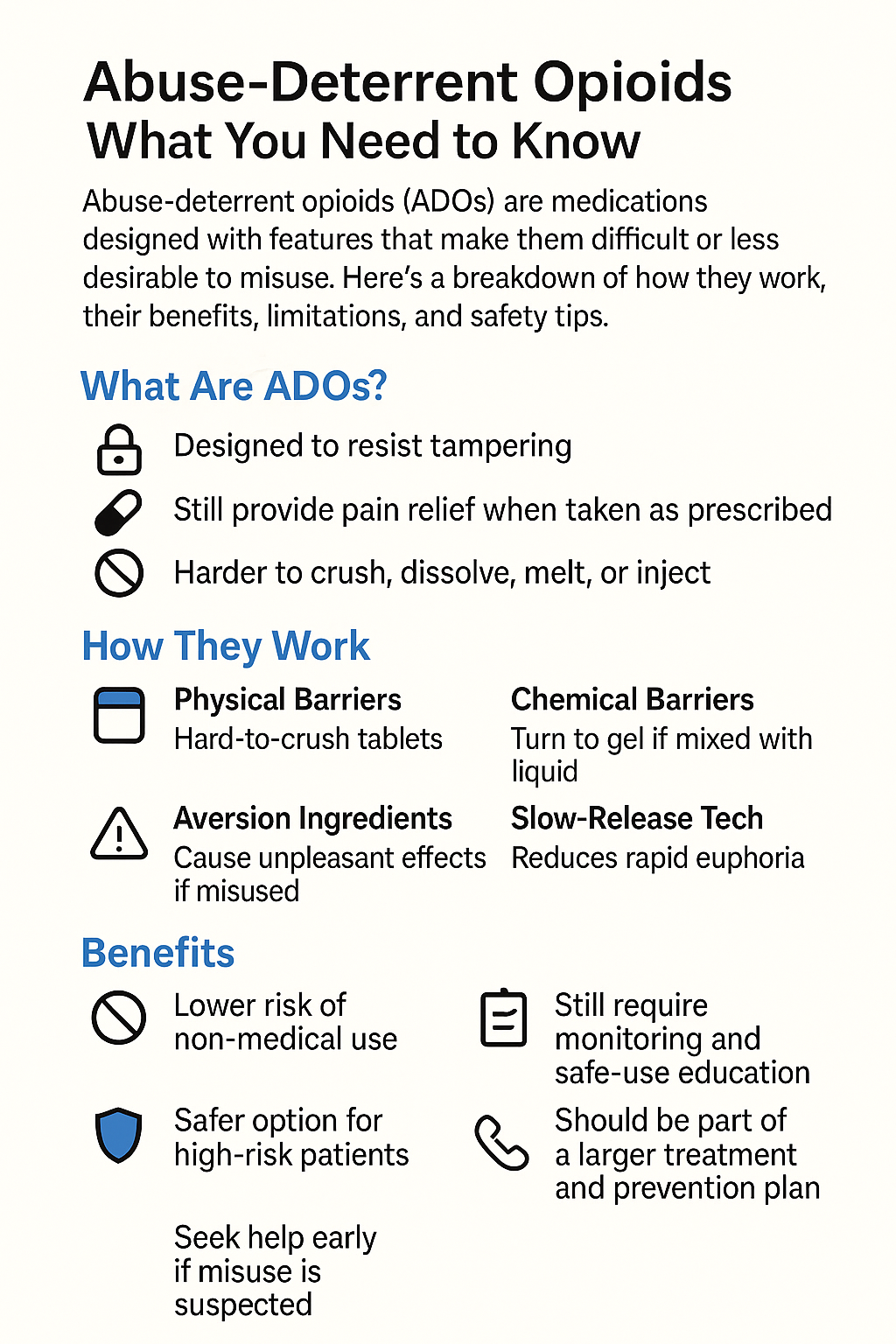Abuse-deterrent opioids reduce misuse by making tampering harder, supported by the government to balance pain management and addiction prevention. While ADFs lower abuse potential, they also bring challenges like high costs, limited access, and risks of shifting to illicit drugs. Ethical concerns over accessibility, autonomy, and privacy emphasize the need for a balanced approach to using ADFs in the opioid crisis.
Understanding Abuse-Deterrent Formulations (ADFs) in Pain Medication
Abuse-deterrent formulations (ADFs) of pain medications are specially designed to make it harder for individuals to misuse or abuse the drug. ADFs aim to reduce addiction risks, overdose, and other adverse outcomes associated with tampering by adding protective features that prevent users from altering the drug’s form to achieve an intense effect.
How Abuse-Deterrent Formulations Work:
- Physical Barriers – These make the pill challenging to crush or chew, preventing easy access to active ingredients.
- Chemical Barriers – Certain chemicals change the drug’s effects if tampered with, causing it to lose potency or induce unpleasant reactions if altered.
- Agonist/Antagonist Combinations – Some ADFs combine the primary drug with a substance that counteracts its misused effects, blocking the euphoric effects if injected or inhaled.
- Extended-Release Mechanisms – These technologies release the drug gradually, preventing abusers from accessing the entire dose at once.
Limitations and Considerations: Though ADFs are primarily used for opioids, they do not eliminate misuse and work best when paired with safe prescribing practices and comprehensive addiction treatment. While ADFs add a layer of protection, a balanced approach involving education, responsible prescribing, and support resources is crucial to tackling the opioid crisis.
Understanding the role and limitations of ADFs in managing pain medication misuse is essential in creating safer medication practices and reducing addiction risk.
Why the Government Supports Abuse-Deterrent Opioid Medications
In response to the opioid epidemic, which has led to high rates of addiction and overdose, the government is promoting the development of abuse-deterrent formulations (ADFs) for opioids. While these medications are effective for pain management, they come with a significant risk of misuse. Abuse-deterrent technologies are designed to prevent tampering (such as crushing or injecting), making it harder to misuse opioids and reducing their appeal on the illicit market.
How Abuse-Deterrent Formulations Help Combat the Opioid Crisis:
- Reducing Misuse – By creating opioids that are harder to tamper with, ADFs aim to lower the risk of misuse and discourage those with substance use disorders from abusing the drugs.
- Addressing Overdose and Promoting Safe Prescribing – The government supports ADFs to lower overdose rates linked to prescription opioids and to encourage safer prescribing practices, helping ensure opioids are used responsibly and only when needed.
- Balancing Pain Relief with Public Health – ADFs enable patients to access pain relief safely under medical supervision while reducing the risk of addiction, supporting a balanced approach to managing pain without overprescribing.
- Encouraging Pharmaceutical Innovation – The government incentivizes pharmaceutical companies to develop ADFs, fostering research into safer pain medications that meet both therapeutic needs and public health goals.
- Reducing Illegal Drug Trafficking and Societal Costs – Abuse-deterrent drugs aim to prevent opioids from entering the illicit drug market, which can minimize addiction-related crime and public health costs.
- Aligning with Broader Addiction Policies – Abuse-deterrent formulations complement national policies aimed at reducing addiction, such as drug take-back programs and increased access to treatment for those already affected.
The government’s promotion of abuse-deterrent opioids reflects its commitment to balancing effective pain management with the need to combat addiction and overdose. By encouraging innovation in safer medications, the goal is to reduce the societal impact of the opioid crisis while ensuring that those who need pain relief can access it safely.
The Downsides of Abuse-Deterrent Opioid Medications
Abuse-deterrent opioid medications (ADFs) are designed to reduce misuse and abuse, but they also have several disadvantages that impact both patients and the broader opioid crisis. Here are some of the primary challenges associated with ADFs:
- Reduced Efficacy for Patients – Abuse-deterrent technologies can alter how a drug is absorbed, potentially leading to less effective pain relief, especially for those with chronic or severe pain.
- Higher Costs – ADFs are often more expensive, making them less accessible for low-income individuals and increasing healthcare costs overall. These higher prices can exacerbate health disparities in communities already struggling with access to treatment.
- Tampering Still Possible – Despite deterrent technologies, determined users may still find ways to misuse these drugs, such as dissolving or heating them to access the active ingredients.
- Limited Impact on the Opioid Crisis – ADFs only address tampering, not the over-prescription of opioids or lack of addiction treatment, which are core issues in the opioid epidemic. This limits their role in fully addressing the crisis.
- Increased Shift to Non-ADF Opioids and Illicit Drugs – When ADFs are more challenging to abuse, some individuals may turn to non-ADF opioids or illicit substances, which can complicate efforts to curb opioid abuse.
- Availability Challenges – Many pain medications are not yet available in abuse-deterrent versions, limiting options for patients who might benefit from ADFs.
- Behavioral Risks – Over-reliance on ADFs can lead to a false sense of security among healthcare providers, potentially reducing monitoring efforts and overshadowing the need for comprehensive treatment approaches.
- Complex Approval Processes – The regulatory path for ADFs is lengthy and complex, delaying the release of these drugs and limiting their immediate impact on the crisis.
Abuse-deterrent opioid medications offer the potential to reduce misuse, but they are far from a cure-all. The challenges they present, from cost and accessibility issues to limited effectiveness in curbing the larger opioid epidemic, suggest that ADFs should be seen as just one tool in a multi-faceted approach to solving the crisis. Comprehensive strategies, including improved prescribing practices, better access to addiction treatment, and public health interventions, are essential to address the complexities of the opioid epidemic fully.
Ethical Dilemmas in Abuse-Deterrent Opioid Medications: Balancing Pain Management and Misuse Prevention
The development of abuse-deterrent opioid medications (ADFs) aims to reduce opioid misuse by making it harder to tamper with these drugs. However, while these formulations are designed to curb abuse, they bring several ethical concerns, particularly around access, patient choice, and the balance between adequate pain relief and addiction prevention. Here are some of the critical moral issues surrounding ADFs:
- Access and EquityAbuse-deterrent formulations are often more costly, making them less accessible for patients with limited financial resources. Vulnerable populations, including those in economically disadvantaged communities, may struggle to afford these options, creating disparities in who benefits from these safer medications and raising concerns about equitable access to care.
- Patient Autonomy and Choice: Patients may feel limited in their treatment choices if abuse-deterrent versions are the only option available, especially if these formulations are less effective for their pain. This can infringe on a patient’s autonomy, particularly if they feel pushed into a solution that does not align with their medical needs. Sometimes, patients might feel coerced by healthcare providers or insurers to use ADFs when they prefer other options.
- Privacy and StigmaTo prevent misuse, patients prescribed opioids may be subjected to increased monitoring measures, such as urine tests or prescription tracking. While these practices are aimed at ensuring safe use, they raise ethical questions about privacy and can contribute to stigma, making patients feel treated as “suspects” rather than individuals with legitimate pain needs. This can also harm patient-provider trust.
- Effectiveness vs. Over-reliance on ADFs: A common concern with ADFs is the potential for over-reliance. Both healthcare providers and patients may assume that the abuse-deterrent features entirely prevent misuse, which could lead to inadequate screening, monitoring, and use of alternative pain management methods. Relying solely on ADFs without other safety measures risks creating a false sense of security that these medications are completely safe from misuse.
- Focus on Formulation Over Root Causes: Focusing primarily on abuse-deterrent medications may shift attention away from broader solutions to the opioid crisis, such as improving addiction treatment access, addressing over-prescription practices, and offering alternative pain management options. The emphasis on medication development can overshadow necessary public health initiatives to address the root causes of opioid misuse.
- Impact on Legitimate Pain Patients: Patients who require opioids for pain relief may find that ADFs do not work as effectively as traditional formulations, which can lead to frustration and inadequate pain management. This creates a dilemma between preventing abuse and ensuring that patients with legitimate medical needs receive appropriate pain relief.
- Pharmaceutical Incentives: The market for ADFs is lucrative, and the potential for higher profits can influence pharmaceutical companies to focus on developing these formulations rather than affordable alternatives or comprehensive treatment solutions. This raises ethical questions about whether the industry prioritizes patient welfare or profits, especially given its role in the opioid epidemic through past marketing practices.
While abuse-deterrent opioid medications play an essential role in reducing misuse, they are not a perfect solution and come with significant ethical challenges. From issues of accessibility and patient choice to the risk of over-reliance on deterrent technologies, ADFs underscore the need for a balanced approach. Solving the opioid crisis requires comprehensive strategies that combine safe prescribing practices, public health initiatives, and addiction support services, ensuring that all patients receive both effective pain relief and protection against misuse.
Conclusion
Abuse-deterrent opioid medications are an essential tool in the fight against opioid misuse, aiming to reduce tampering and abuse while still providing pain relief for legitimate users. Government involvement has been crucial in encouraging their development. Yet, these medications come with both advantages and disadvantages, such as higher costs, limited accessibility, and the potential for misuse through alternative means. Ethical dilemmas surrounding ADFs, such as concerns about patient autonomy, privacy, and the focus on medication over comprehensive addiction prevention, highlight the need for a more holistic approach. Balancing the benefits and challenges of ADFs is essential to ensure that they contribute effectively to the overall goal of reducing opioid addiction and overdose.
Video: The Shocking Truth About Opioid Misuse and How ADOs Can Help

